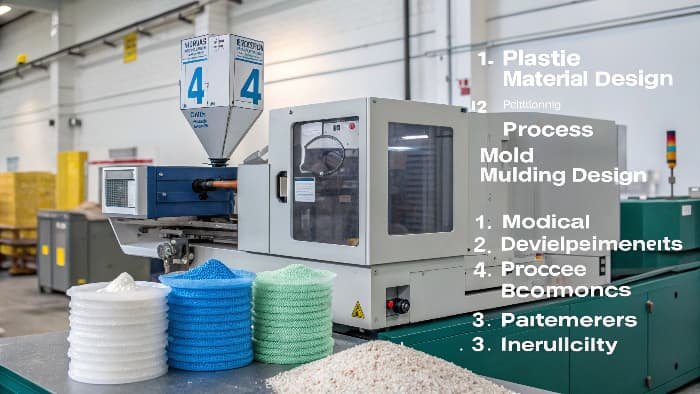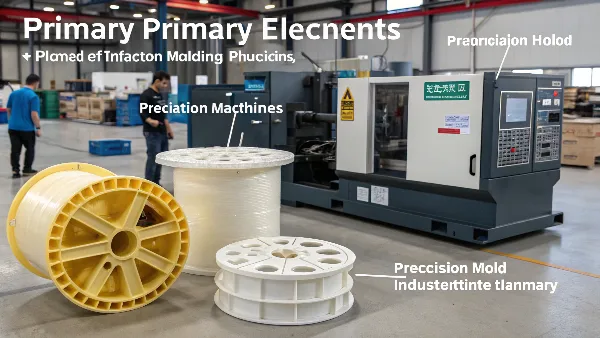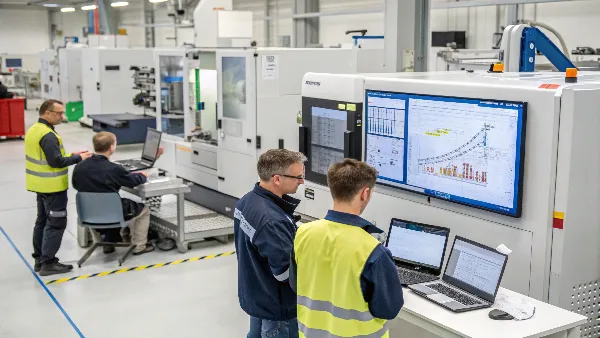Getting truly precise plastic parts feels impossible sometimes, right? Defects pile up, deadlines slip, and costs rise. We have ways to fix that.
At CKMOLD, we tackle precision challenges1 head-on. We do this through careful process tuning, using smart tech like simulation software2, picking the right materials and mold designs, working closely with you, and investing in top-notch equipment and skilled people.
Getting precision right isn’t just luck. It really boils down to understanding the key pieces of the puzzle and paying attention to the details. If you want consistent, high-quality parts3, you need a solid approach. Let’s dig into how we make that happen and what you should look for.
How Precise Can Injection Molding Actually Be?
You’ve got a design with tight tolerances, maybe for a critical medical device or a complex electronic housing. You wonder, can injection molding really hit those numbers consistently? It’s a fair question, and the uncertainty can stall good projects.
Injection molding can be incredibly precise! We often hit tolerances down to +/- 0.001 inches (that’s 0.025 mm), and sometimes even tighter. But, honestly, it depends a lot on the plastic used, how complex the part is, the quality of the mold itself, and keeping the process super stable.
| Achieving high precision isn’t automatic; it’s something you have to actively work towards. Several things can limit just how tight you can get those tolerances. The plastic material itself is a big one – different plastics shrink differently as they cool, and some are just less stable dimensionally. Fillers like glass fiber can also affect shrinkage and warpage. The complexity of the part design plays a huge role too. Thin walls, sharp corners, or big variations in thickness can all make holding tight tolerances tougher. Then there’s the mold tool. It has to be built with extreme accuracy itself. Things like the steel quality, the precision of the machining, and how well the cooling channels work are critical. Even tiny amounts of wear on the mold over time can affect part dimensions. And finally, the molding process control – keeping temperatures, pressures, and speeds exactly the same shot after shot is vital. We’ve seen some amazing results. [Placeholder: Add a personal story here about a time we achieved surprisingly tight tolerances for a client’s complex part, maybe mentioning the material and the challenge.] It takes effort, but it’s doable. For super tiny parts, there’s even micro-molding, pushing precision to incredible levels. Here’s a rough idea: |
Feature Tolerance | General Purpose Molding | Precision Molding | Micro-Molding |
|---|---|---|---|---|
| Typical Tolerance (inch) | +/- 0.005" | +/- 0.001" – 0.002" | < +/- 0.001" | |
| Typical Tolerance (mm) | +/- 0.125 mm | +/- 0.025 – 0.050 mm | < +/- 0.025 mm | |
| Key Factors | Cost, Speed | Material, Mold, Process | Specialized Everything |
So yes, injection molding can be very precise. It just requires the right approach, materials, tooling, and control.
What Are the Four Primary Elements Influencing the Injection Molding Process?
Ever get a batch of parts and some are perfect, while others are… not so much? Wondering what makes the difference? Ignoring the core elements that control molding is often the reason for inconsistency and those frustrating quality headaches.
Think of it like baking a cake. You need the right ingredients, the right pan, the right oven, and the right recipe settings. For injection molding, the four key elements are: the Plastic Material, the Mold Design, the Molding Machine, and the Process Parameters used. Getting these four in harmony is absolutely crucial for success.

Let’s break these down a bit, because understanding them is key to troubleshooting and improving your parts. It’s something I learned early on working on the factory floor, and it still holds true today.
Plastic Material Matters
This seems obvious, but it’s more than just picking "ABS" or "Polycarbonate." Every specific grade of plastic behaves differently. You need to know its melt flow rate (how easily it flows), its shrinkage rate (how much it shrinks when cooling), its moisture sensitivity (some plastics need drying!), and if it has fillers (like glass or talc) that affect strength and shrinkage. Using the wrong grade, or even inconsistent batches of the right grade, can cause big problems. [Placeholder: Share an anecdote about overcoming challenges with a tricky material like glass-filled nylon, highlighting the importance of understanding material behavior and proper drying.]
Mold Design is King
The mold isn’t just a cavity shaped like your part. It’s a complex piece of engineering. How the plastic enters the cavity (gate location and size), how air escapes (venting), and especially how the part cools (cooling channel layout and efficiency) have a massive impact on the final part’s quality, dimensions, and appearance. A poorly designed mold will fight you every step of the way, no matter how good your machine or process is. We spend a lot of time on Design for Manufacturability (DFM) reviews because of this.
Machine Capabilities Count
The injection molding machine does the heavy lifting. Its ability to accurately control temperatures (barrel and nozzle), injection speed, injection pressure, hold pressure, and clamping force is vital. An older or less precise machine might struggle to maintain the consistency needed for tight-tolerance parts. You need the right size machine for the mold (shot size, clamp tonnage) and one that offers repeatable performance.
Process Parameters are the Recipe
These are the specific settings dialed into the machine for your part and your mold. Things like injection speed profile, pack/hold pressure and time, cooling time, melt temperature, and mold temperature. Finding the optimal window for each parameter, often through systematic experimentation like Design of Experiments (DOE), is critical for achieving quality and consistency. It’s not just about finding settings that make a part, but settings that make a good part, reliably.
These four elements don’t work in isolation; they all interact. Changing the material might require tweaking the process parameters and could even highlight limitations in the mold design. It’s a system, and you need to understand all the pieces.
How Can You Improve the Quality of Injection Molding?
Are you tired of seeing defects like sink marks, warping, flash, or short shots in your molded parts? Trying to improve quality can feel like a constant uphill battle, eating up time, material, and money. Let’s talk about making it better.
You improve molding quality by taking a step back and looking at the whole picture. Optimize the mold design first – pay close attention to gates and cooling. Choose the right plastic and handle it properly. Fine-tune those process settings carefully. And don’t forget regular mold and machine maintenance. It’s not one magic fix, but a combination of things.

Improving quality isn’t about luck; it’s about being systematic. I remember working on a part that just kept warping, no matter what we tweaked on the machine. It was frustrating! Here’s what usually makes the biggest difference:
Nail the Mold Design (Especially Cooling & Gating)
Often, quality problems start here. Before steel is even cut, using simulation software like Moldflow can predict potential issues like uneven filling, air traps, or problematic shrinkage and warpage. This lets you optimize gate locations, runner sizes, and importantly, the cooling layout. Uniform cooling is probably one of the most critical factors for dimensional stability and preventing warp. Good venting is also essential to avoid trapped gas issues.
Material Selection & Consistent Handling
Using the correct grade of plastic is step one. But step two is handling it correctly. Many engineering plastics absorb moisture from the air, which can cause splay marks or weak parts if not dried properly before molding. Using dryers and ensuring consistent material lot-to-lot is key. Don’t underestimate this!
Process Optimization (Scientific Molding Approach)
Instead of just guessing settings, use a more scientific method. This involves understanding the plastic’s behavior and systematically finding the optimal processing window for injection speed, pressure, temperature, hold time, etc. Techniques like Design of Experiments (DOE) can help identify the most critical parameters and their ideal ranges for your specific part and mold. This leads to a more robust and repeatable process.
Quality Control & Monitoring
You can’t improve what you don’t measure. Implement in-process checks (visual, critical dimensions) and use more advanced tools like Coordinate Measuring Machines (CMM) for detailed part inspection. Tracking quality data helps identify trends or shifts quickly.
Consistent Maintenance is Key
| A dirty or worn mold won’t make good parts. Regular cleaning, inspection, and preventative maintenance of the mold are crucial. Likewise, keeping the molding machine calibrated and well-maintained ensures it performs consistently shot after shot. [Placeholder: Describe a specific case where we tackled a persistent quality issue like warpage using simulation and process adjustments, showing the step-by-step improvement. Maybe link it back to the warping issue mentioned earlier.] Here’s a quick cheat sheet for common issues: |
Defect | Common Causes | Potential Solutions |
|---|---|---|---|
| Sink Marks | Thick sections, insufficient hold pressure/time | Core out thick areas, increase hold pressure/time, relocate gate | |
| Warpage | Uneven cooling, differential shrinkage, bad gating | Improve cooling uniformity, adjust process temps, change gate location | |
| Flash | Low clamp force, high injection pressure, mold damage | Increase clamp tonnage, reduce pressure, check mold parting line | |
| Short Shot | Insufficient material, low pressure/speed, poor venting | Increase shot size, boost pressure/speed, improve venting | |
| Burn Marks | Trapped air overheating, high injection speed | Improve venting, reduce injection speed, lower melt temperature |
Fixing quality issues requires looking at the mold, material, machine, and process.
So, How Does CKMOLD Specifically Solve Injection Molding Problems?
You might be facing a tricky molding challenge – maybe parts aren’t meeting spec, scrap rates are too high, or your current supplier just isn’t delivering. Finding a partner who doesn’t just make parts, but actually solves these kinds of problems can feel like searching for a unicorn.
At CKMOLD, we solve problems by mixing deep hands-on experience – like my own years in the factory – with modern technology. We use tools like mold flow simulation, detailed process analysis (often using DOE), and most importantly, we work with you right from the beginning. We focus hard on getting the material and design right, and rely on our skilled team and precise equipment.

Look, making plastic parts, especially precise ones, isn’t always straightforward. Things go wrong. The key is how you approach fixing them. We don’t just tweak knobs randomly. Our approach is more structured, built on years of learning what works. For clients like Michael, who rely on consistent quality for their own manufacturing, this reliability is everything.
Early Collaboration and DFM
We believe strongly in Design for Manufacturability (DFM). This means we like to get involved early, looking at your part design before the mold is made. We can often spot potential issues – like areas prone to warping or features that will be hard to fill – and suggest changes that make the part easier and more reliable to mold, saving headaches later. We talk directly with your engineers.
Advanced Simulation Tools
Why guess when you can simulate? We use software like Moldflow to digitally simulate the injection process. This helps us predict how the plastic will fill the mold, where potential defects might occur (like weld lines or air traps), and how the part will cool and shrink. It lets us optimize the mold design (gates, cooling) on the computer, reducing trial-and-error on the press.
Process Optimization Expertise
Our team understands scientific molding principles. We don’t just rely on old setups. We establish optimal process parameters based on data, finding a stable window that produces good parts consistently, even with minor variations in material or environment. This often involves systematic studies (DOE) to understand how different settings affect the outcome.
Material & Design Focus
With my background starting on the factory floor and then building a trading company, I’ve seen countless materials and designs. We leverage this experience to help select the best material for the application and ensure the mold design incorporates best practices for that specific plastic and part geometry.
Quality Equipment & Skilled Team
You can have the best process, but you still need good tools and good people. We invest in well-maintained, precise injection molding machines and measurement equipment. And our technicians and engineers are experienced problem-solvers, trained to monitor the process and spot potential issues quickly.
Continuous Improvement Loop
Every project is a learning opportunity. We track performance, analyze any issues that arise, and feed that information back into our processes. We aim to get better with every mold we build and run. [Placeholder: Detail a success story, perhaps referencing a challenge similar to Michael’s (e.g., tight tolerance consumer electronic part), where close collaboration and our specific methods led to a great outcome and strengthened the partnership.] Communication is key here – we keep you in the loop.
Ultimately, solving problems comes down to combining technical knowledge, the right tools, and a collaborative, systematic approach. That’s how we tackle challenges at CKMOLD.
Conclusion
So, overcoming precision molding challenges is definitely possible. It hinges on understanding how precise molding can be, mastering the four core elements, systematically improving quality, and having a robust problem-solving approach like ours at CKMOLD.
-
Explore this link to discover effective strategies and insights for tackling precision challenges in manufacturing processes. ↩
-
Learn how simulation software can enhance your manufacturing efficiency and precision, making it a valuable resource for your operations. ↩
-
This resource will provide you with essential factors and techniques to ensure the production of high-quality parts consistently. ↩
